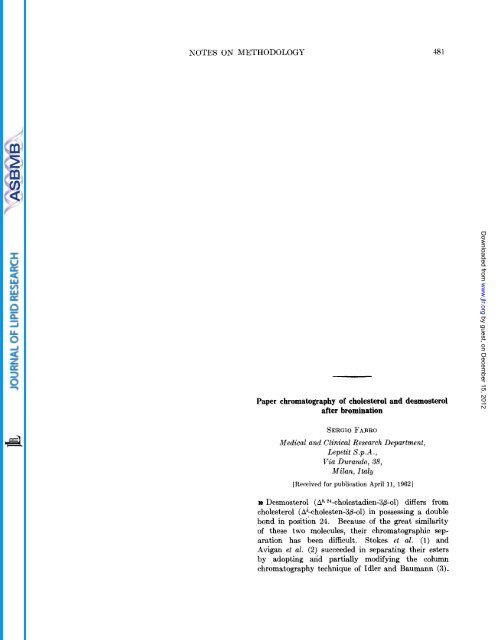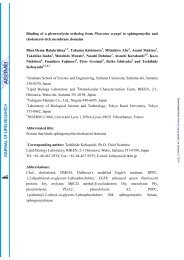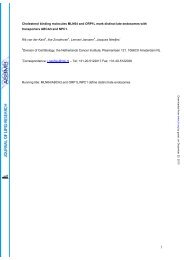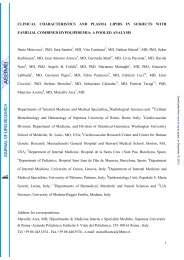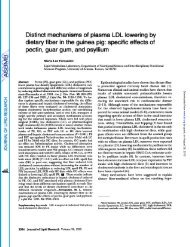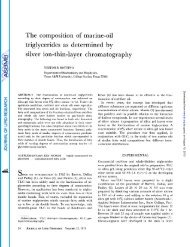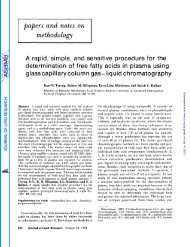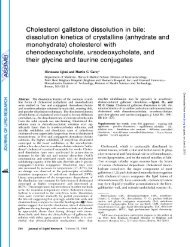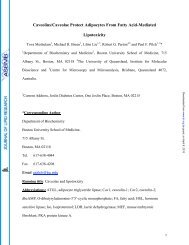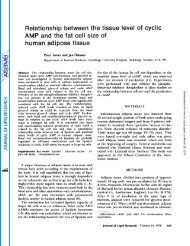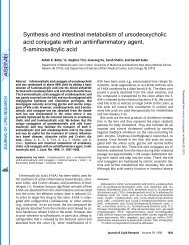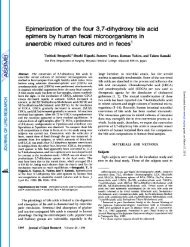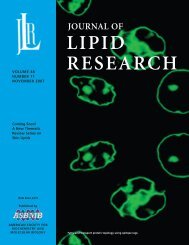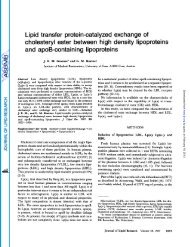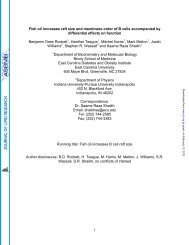NOTES ON METHODOLOGY Paper chromatography of cholesterol ...
NOTES ON METHODOLOGY Paper chromatography of cholesterol ...
NOTES ON METHODOLOGY Paper chromatography of cholesterol ...
You also want an ePaper? Increase the reach of your titles
YUMPU automatically turns print PDFs into web optimized ePapers that Google loves.
<strong>NOTES</strong> <strong>ON</strong> <strong>METHODOLOGY</strong> 48 1<br />
<strong>Paper</strong> <strong>chromatography</strong> <strong>of</strong> <strong>cholesterol</strong> and desmosterol<br />
after bromination<br />
SERGIO FABRO<br />
Medical and Clinical Research Department,<br />
Lepetit S.p.A.,<br />
Via Durando, 38,<br />
Milan, Ita15<br />
[Received for publication April 11, 19621<br />
11 Desmosterol ( A5* 24-cholestadien-3fl-01) differs from<br />
<strong>cholesterol</strong> (A5-cholesten-38-01) in possessing a double<br />
,bond in position 24. Because <strong>of</strong> the great similarity<br />
<strong>of</strong> these two molecules, their chromatographic sep-<br />
aration has been difficult. Stokes et al. (1) and<br />
Avigan et al. (2) succeeded in separating their esters<br />
by ,adopting and partially modifying the column<br />
<strong>chromatography</strong> technique <strong>of</strong> Idler and Baumann (3).<br />
Downloaded from<br />
www.jlr.org<br />
by guest, on December 15, 2012
482 <strong>NOTES</strong> <strong>ON</strong> <strong>METHODOLOGY</strong><br />
More recently, Holmes and Stack (4) have used gas<br />
<strong>chromatography</strong> for their separation.<br />
As the <strong>cholesterol</strong> and desmosterol molecules take<br />
up different quantities <strong>of</strong> bromine (2 and 4 atoms per<br />
mole respectively), I thought it would be rewarding to<br />
exploit this difference and investigate a method <strong>of</strong><br />
separating these two compounds by paper <strong>chromatography</strong><br />
after bromination. Descending <strong>chromatography</strong><br />
on paper impregnated with p-hydroxyethylphenylether,<br />
using hexane as solvent, proved to be the most suitable<br />
system.<br />
The desmosterol was supplied by W. S. Merrell<br />
Company, Cincinnati, Ohio. All the other substances<br />
were reagent grade. Sheets <strong>of</strong> 3 MM Whatman paper<br />
18-30 cm wide by 53-55 cm long were impregnated with<br />
a 10% solution <strong>of</strong> /3-hydroxyethylphenylether in<br />
acetone. After removal <strong>of</strong> the acetone by aeration,<br />
the sterols in a sulphuric ether solution were placed on<br />
the starting line <strong>of</strong> the impregnated sheet at a distance<br />
<strong>of</strong> 4 cm from one another. The quantity <strong>of</strong> sterols<br />
ranged from 50 to 200 pg.<br />
In the first experiments, bromination was effected by<br />
applying a few drops <strong>of</strong> a 10% solution <strong>of</strong> bromine in<br />
CCl, directly to the product at its starting point on the<br />
paper, the excess bromine being removed by a draught<br />
<strong>of</strong> cold air. In other experiments, the process was<br />
accomplished with the sterols in a sulphuric ether solution<br />
by adding bromine drop by drop until the solut.ion<br />
assumed a stable orange color. After 15 min.,<br />
the excess bromine was removed by washing the solution<br />
3 times with sodium thiosulphate, 0.1 M, and then<br />
with H20. The ether solution <strong>of</strong> brominated sterols<br />
was reduced to a low volume under vacuum and<br />
then placed on the paper. The two methods yielded<br />
identical results.<br />
Descending <strong>chromatography</strong> was carried out in an<br />
atmosphere saturated with P-hydroxyethylphenyletherhexane<br />
at a temperature <strong>of</strong> 22' f 3O, using as solvent<br />
a solution <strong>of</strong> hexane saturated with @-hydroxyethylphenylether<br />
at the experimental temperature. The<br />
time taken by the front <strong>of</strong> the solvent to effect a run <strong>of</strong><br />
about 45 cm was generally 2 hr. The brominated compounds<br />
were revealed, after the chromatographic<br />
run, by placing the sheet, previously heated to 115O<br />
for 20 min., under UV light.<br />
The brominated products <strong>of</strong> <strong>cholesterol</strong> and desmosterol<br />
exhibited an intense yellowish-white fluorescence<br />
under the above conditions, whereas the respective<br />
unbrominated compounds were not fluorescent. The<br />
<strong>cholesterol</strong> and desmosterol in the system used proved<br />
to have a practically identical R, value (0.72 for <strong>cholesterol</strong><br />
and 0.68 for desmosterol), whereas their<br />
brominated compounds were sharply separated: cho-<br />
lesterol 0.69 f 0.06 (16 experiments) and desmosterol<br />
0.42 i 0.07 (13 experiments). The slight variation<br />
from experiment to experiment was due, in all prob-<br />
ability, to the difficulty <strong>of</strong> impregnating the sheet<br />
with /3"hydroxyethylphenylether in a rigorously con-<br />
stant manner, as Seher and Wettstein (5) pointed out<br />
some time ago. On chromatographic separation <strong>of</strong><br />
brominated desmosterol (100-200 pg), two other small<br />
fluorescent spots become visible under UV light after<br />
heating in addition t,o the one with Rl 0.42: one<br />
FIG. 1. Chromatographic separation<br />
<strong>of</strong> deamosterol from <strong>cholesterol</strong> aft,er<br />
bromination. D = desmosterol (200<br />
fig); c = (2oocrg).<br />
with an Rl <strong>of</strong> 0.05; and another, very faint and blurred,<br />
with an Rl <strong>of</strong> 0.15. Brominated <strong>cholesterol</strong> under<br />
identical conditions always exhibited a singlelt$pot<br />
with Rl 0.69 (Fig. 1).<br />
These compounds, which become visible after chro-<br />
matography <strong>of</strong> brominated desmosterol, appeared also<br />
after <strong>chromatography</strong> <strong>of</strong> the unsaponifiable fraction <strong>of</strong><br />
plasma or <strong>of</strong> organs (liver, kidney, lung) <strong>of</strong> animals<br />
treated with triparanol (Fig. 2). Here again, two<br />
other small spots, definitely comparable in R, 'and in<br />
Downloaded from<br />
www.jlr.org<br />
by guest, on December 15, 2012
XOTES <strong>ON</strong> <strong>METHODOLOGY</strong> 183<br />
fluorescence to those obtained in the <strong>chromatography</strong> REFERENCES<br />
<strong>of</strong> desmosterol, are visible under UV light together with 1. Stokes, w. M., w. A. Fish, and F. c. Hickeye J. Bwl.<br />
the spots <strong>of</strong> <strong>cholesterol</strong> and desmosterol. It is not yet Chem. 220: 415, 1956.<br />
possible to say whether they correspond to secondary 2. Avigan, J., D. Steinberg, H. E. Vroman, XI. .J. Thompson,<br />
compounds obtained in the bromination <strong>of</strong> desmosterol and E. Mowttig. J. Bid. them. 235 : 31% 1960.<br />
3. Idler, D. R., and C. A. Baumann. J. Bwl. Chem. 195:<br />
623, 1952.<br />
4. Holmes, W. L., and E. Stack. Bwchinz. et Biophys. ;letu<br />
56: 163, 1962.<br />
5. Seher, R., and A. Wettstein. Helv. Chim. -4th 35: 276,<br />
1952.<br />
FIG. 2. Chromatography <strong>of</strong> the bro-<br />
minated unsaponifiable fraction <strong>of</strong><br />
pooled organs (liver, kidney, lung) <strong>of</strong><br />
rata treated with triparanol (12.5 mg<br />
daily for 30 days). The hrominated<br />
<strong>cholesterol</strong> and desmosterol are recog-<br />
nizahle. Further, there are two fluores-<br />
cent zones with R, values <strong>of</strong> 0.05 and<br />
0.15 lust as occurs with the chroma-<br />
tography <strong>of</strong> desmosterol. The chroma-<br />
tographic conditions are as described<br />
in the text. The photograph was taken<br />
under ultrnviolet light.<br />
or whether they accompany the desmosterol. If the<br />
latter is the case, and the possibility cannot be ex-<br />
cluded since the grade <strong>of</strong> purity <strong>of</strong> the desmosterol<br />
used as standard was not known, then t,hey must<br />
correspond to compounds, probably sterols, that form<br />
in animals treated with triparanol.<br />
Downloaded from<br />
www.jlr.org<br />
by guest, on December 15, 2012


